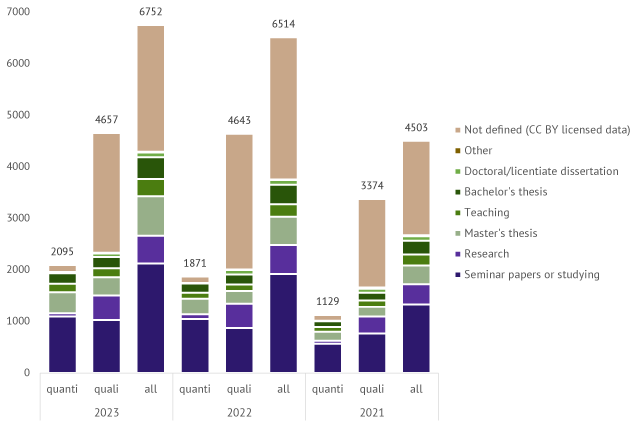Use of FSD data grew at a more moderate pace than in previous years
In 2023, FSD services were widely used and the number of datasets users downloaded from Aila Data Service was again higher than ever before. However, the growth in data use was more moderate than in previous years and displayed slightly different trends. The largest increases were seen in data use for the purposes of Master’s theses and teaching, but the use of data freely available under the CC BY 4.0 license decreased somewhat. The number of registered users continued to grow.
Last year, data downloads from Aila Data Service saw an increase of 4% from 2022. In total, FSD processed 5,991 access applications in 2023 (2022: 5,863). In 2023, 6,752 datasets were delivered for reuse (2022: 6,514), of which 69% were quantitative (2022: 71%) and 31% qualitative (2022: 29%). All in all, between 2014 and 2023, approximately 34,300 datasets have been downloaded from Aila.
Of the downloaded datasets, 36% were (A) freely available under the CC BY 4.0 license. In 2022, the corresponding figure was 42%. In previous years, datasets (A) freely available under the CC BY 4.0 license have seen the strongest growth in usage, but in 2023 the increase in data downloads was targeted at non-freely available datasets. This is largely explained by the fact that European Social Survey (ESS) datasets, which were previously freely available, now require registration to access.
In 2023, 2,472 freely available datasets were downloaded, compared to 2,767 downloads in 2022. Presently, datasets with access condition (A) account for 8% of all datasets available on Aila. 58% of downloads were of datasets which require registration and are available for (B) research, teaching and study. Datasets with access condition (B) account for 76% of all datasets on Aila.

Datasets were primarily used by registered users in Finnish higher education institutions. The most data were downloaded at Tampere University (26%), the Universities of Helsinki (13%), Eastern Finland (11%), Jyväskylä (10%), Oulu (9%) and Turku (9%). 6% of the dataset downloads came from registered users abroad (2022: 6%), and 17% of the datasets were downloaded from the English data catalogue of Aila (2022: 13%). Users downloaded datasets most actively in January and October.
Upsurges in the use of qualitative datasets and data use for teaching and studying purposes
Registered users downloaded datasets for teaching and studying purposes in greater numbers than in previous years. Datasets were downloaded particularly for the purposes of Master’s theses (an increase of 40% compared to 2022) and teaching (an increase of 37% compared to 2022). Additionally, downloads of qualitative datasets increased by 12% in comparison to 2022. The use of datasets (A) freely available under the CC BY 4.0 license, which have been increasingly popular in previous years, decreased by 11% in 2023.
As in 2022, the most popular dataset in 2023 FSD3217 European Social Survey 2016: Finnish Data (Opens in a new tab) , which studied views on climate change, energy security and well-being. Of the datasets published in 2023, the most downloaded datasets were FSD3754 Public Procurement Notices 2022 (Opens in a new tab) and FSD3603 FSD3603 University Students' Views on the Future 2021 (Opens in a new tab) . The qualitative textual data in FSD3603 University Students' Views on the Future 2021 (Opens in a new tab) was collected using FSD’s data collection tool Penna.
Continued upward trend in the number of archived datasets and registered users
A record number of 127 new datasets were published on Aila Data Service in 2023 (2022: 88), of which 97 were quantitative datasets (2022: 62) and 30 qualitative datasets (2022: 26). 35 openly accessible datasets were published on Aila Data Service in 2023 (2022: 15). At the end of the year, Aila contained a total of 1,902 datasets, of which 1,564 were quantitative and 338 qualitative. FSD’s data repository gained 93 new datasets in 2023 (2022: 129).
In 2023, 2,239 unique registered users downloaded data from Aila (2022: 1,843). Overall, there were 5,489 registered Aila users at the end of 2023 (2022: 4,485).
The overall use of the FSD website in 2023 increased slightly compared to 2022. The Research Methods Web Resource (MOTV) and other Finnish language content received the most site requests. The number of site requests also remained high for the Finnish Party Agenda Database (Pohtiva) service, as would be expected during a parliamentary election year.
You can learn more about data use rates and other FSD operations in the annual report published online later this spring (in Finnish).
